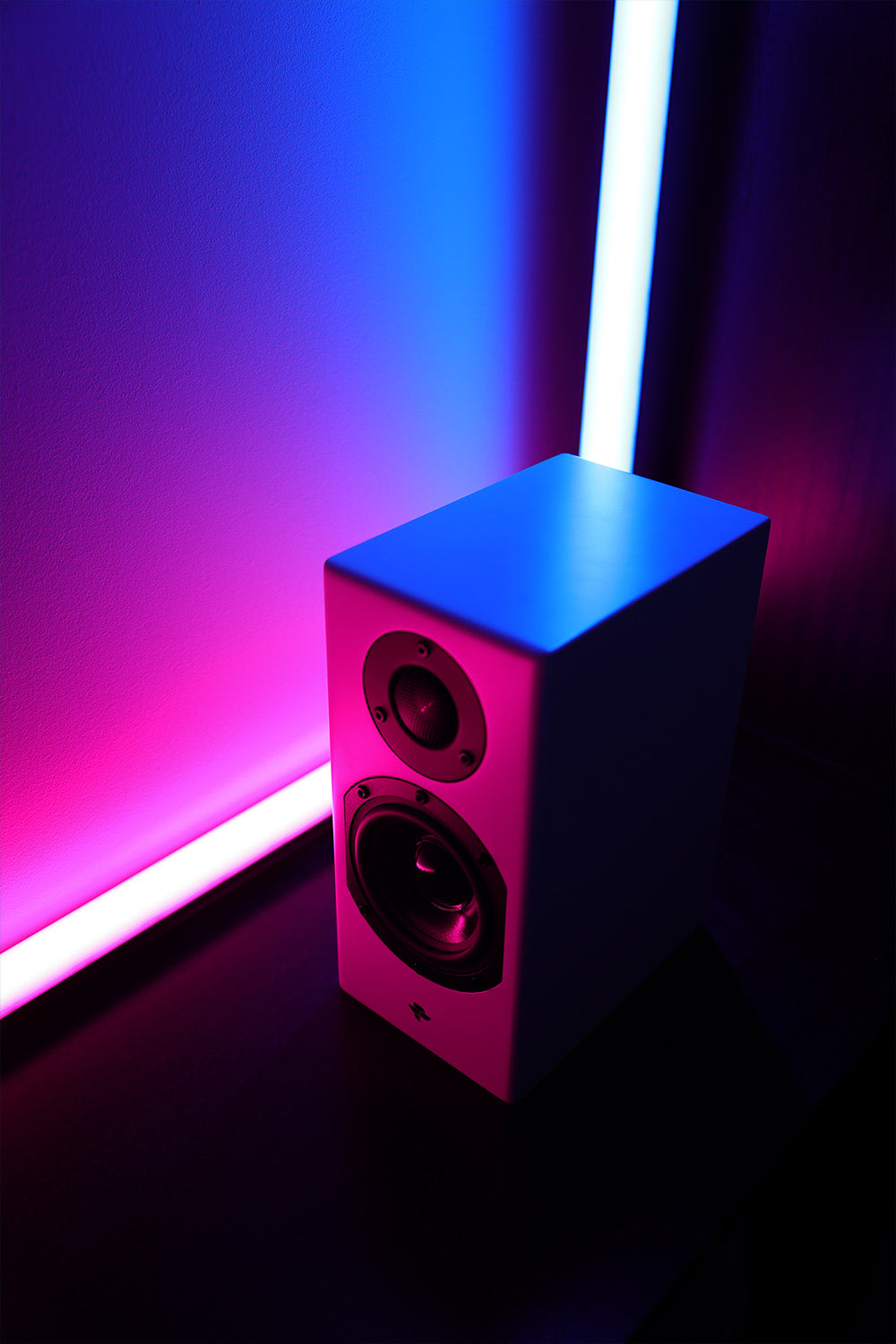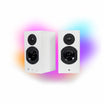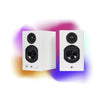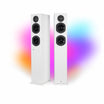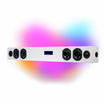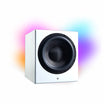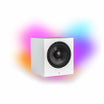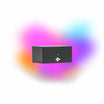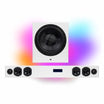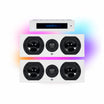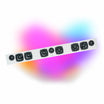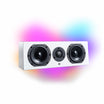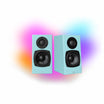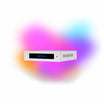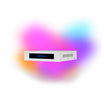
KIN powered products
Why am I not getting any sound output?
Here are some of the first things to check when not getting sound form a KIN powered speaker:
- Check to see if the MUTE setting has been engaged.
- Make sure the correct source has been selected.
- Verify that the system is powered up and properly connected.
Why am I getting no sound when connected to my TV or video source?
Make sure you are using the correct output. TVs have a lot of inputs but few, if any, outputs. The most popular output available on the majority of TVs is an Optical Output. Verify you are properly connected to the Audio Output and not an input.
Why there is no power/no light in the LED/status indicator?
- Verify the main power switch on the amp panel has been turned on.
- Verify that the wall AC outlet is functional.
- Check to see the power cord is securely connected to the speaker.
Why can't I connect to Bluetooth?
- Ensure the Bluetooth input has been selected on the speaker. Depending on the speaker, this is signified by a solid blue light or the word BLUETOOTH in the display.
- Confirm the speaker has been placed into pairing mode, signified by a flickering blue light or the word BLUETOOTH blinking in the display.
- On the Bluetooth device, turn the Bluetooth function on and off. Try pairing again.
- If the device doesn’t find the speakers in pairing mode, turn the main power of the speakers off for a minute, and then on again.
Why am I only getting sound from one speaker?
- Verify the speaker wire is securely attached at the back of both speakers. The most secure connection is made by removing the small plugs in the speaker terminal shafts. This can be done by unscrewing the knob completely, removing the plug, and screwing the knob back into place. Inserting the banana plugs through the holes in the shaft is not recommended for the supplied banana plugs. This option is used for bare wire only.
- Check the interconnects of the attached sources. If you are using stereo RCA cables, one might be loose.
- Try a different source to see if the issue is common to all sources. This will help determine if the issue is associated with a connection or an amplifier issue.
Why the Remote Control is not working properly
- Check to see if the transparent film separating the battery from the connections has been removed.
- Be sure that you are within range (approximately 30ft). Aim the remote at the active speaker.
- Replace the battery.
Why I have very Low Output?
- Many sources, like phones or tablets, have their own volume controls. Ensure their volumes are set to higher levels.
- Some sources can play substantially louder than others, verify if all sources have the same output. If the issue lies with one source then verify the connections and output of that source.
- See if both speakers are playing.
Why I am hearing Distortion, getting Poor Quality sound?
- Bass and treble setting might be misadjusted, push the reset button on the remote.
- Video sources must be set to stereo, not a surround effect like Dolby or DTS.
- Verify the polarity of speaker connections. Incorrect connections can cause a lack of bass or image.
Can I add a powered subwoofer?
A powered subwoofer can be easily added by connecting a single RCA cable from the Sub Out on the KIN powered speaker to the Input on the subwoofer. Or, add the Totem LINK wireless transmitter to add the KIN SUB 10 or Tribe Solution Sub without the need for wires. The KIN Play Sound Bar has the subwoofer transmitter built in and does not require the LINK to add a sub wirelessly. Adding a Totem subwoofer will substantially add to the bass capabilities of the system.
Why there is no Subwoofer Output?
- Verify that the wire is securely connected.
- Make sure that the proper input is being used on the subwoofer.
- If the subwoofer is on and properly connected, increase its volume.
Why I am getting Poor Turntable output?
- Determine if you are using the proper Line or Phono selection. Using the wrong selection can result in very low, distorted output. If the turntable has a built-in Phono Pre-Amp, set the switch located below the input to Line. If it does not, set it to Phono. Ensure the ground wire is connected.
- Separate the speakers farther away for the turntable. The powerful magnets in the woofers can affect the performance.
- Try further isolating the turntable, preferably on a separate shelf. The strong bass output of the speakers can cause the need to vibrate and skip.
What are the included rubber bumpers for?
These are sound isolation feet. If the KIN speakers are placed on furniture like a wall unit or AV furniture or even stands, installing these feet on the bottom of the speaker prevents vibrations and resonances being transferred to the furniture. This means items within the furniture will not rattle and midrange and bass frequencies will be tighter and more accurate.
What kind of speaker stands can I use?
Generally you want the tweeter roughly ear level when in the seated listening position. Stands should ideally be approximately 24-28” tall. Stands too short will limit the affect of the high frequencies.
Is the subwoofer output filtered?
Yes, it is filtered at 200Hz.
What exactly does the Multi Control do?
Located on the bottom right of the active speaker, this multipurpose control can be used for adjusting volume, Bluetooth pairing, and changing input.
It can be turned to the right to increase the volume, left to lower the volume.
A short push on the control activates the input select function and allows you to scroll through the sources. A long push on the control activates the Bluetooth pairing function, and the blue light in the LED Indicator will flash indicating you are in pairing mode.
Does the indicator light stay on all the time or does it disappear?
The indicator light stayed on for the very first generation of KIN Play. The light disappears after approximately 10 seconds on all new models.
What is the AMP IN input for?
The AMP IN input bypasses the internal preamplifier so features like volume and source select will not function. This facilitates connecting and the functionality of external streaming components. Once connected, the speaker will be controlled by the connected device.

Passive speakers
What is a break in period?
Just like a high performance engine needs some miles on it before being pushed, or an athlete stretching before a game, a speaker needs break in time before it will perform to its full potential.
Kin speakers contain several moving parts that have never actually moved before you have purchased them. Essential pieces of the assembly like the spider and the surround will be stiff at first. Due to the rigidness of your new speakers, they will not be as dynamic until they have had a chance to move and become more flexible.
How do I break in speakers?
The easiest answer is simply to play music. However, to break your speakers in well, you’ll want to play something with large dynamic range, something with solid deep bass, as well as something with strong high end. You will want to play the music at a comfortable level but avoid very high volume. If you do it with music that you know well, as you will be able to recognize when the magic starts to happen.
What is the suggested Positioning for Totem (and KinbyTotem) speakers?
Our speakers create a three-dimensional, accurate soundstage without requiring any “toe-in”, or angling towards the listening area. If the distance between them is greater than 8 feet (2.5 m) and the room acoustics are having a substantial effect to the imaging, then you can experiment with angling them. Start by toeing-in one speaker slightly and then the other, if needed. Gradual experimentation is the key.
Totem generally recommends that speakers be positioned 12 in (30.5 cm) from the back wall and side wall to allow a better energy flow and cleaner bass response. Moving them closer to boundaries will result in more bass enhancement but can negatively affect the perceived depth of the soundstage. Moving them farther will result in less bass reinforcement. Placing them anywhere from 4-10 feet (120-300 cm) apart will generally ensure a proper stereo image. A popular guideline is for the listening position distance to be 1.5 times the space between the speakers, so if speakers are 6 feet (180cms) apart you would be 9 feet (270cms) from them.
How do I place and position my bookshelf/monitor speakers?
Follow the same guidelines as outlined in the FAQ “What is the suggested Positioning for Totem speakers?” But, there are some differences for bookshelf speakers, based on their size. Bookshelf speakers should be placed on appropriate stands, or shelves, at ear level or above.
How do I position my speakers for surround sound?
Whether surround or stereo, the placement guidelines for the front two channels are the same. Here are some suggestions for the additional channels used in home theater set ups. Surround speakers are generally placed behind and adjacent to the listening area, at a height of approximately 6 feet. In 7.1 systems, they are also located behind the listening position.
Center Channel Speakers are designed for dialog and main action to emanate from the video screen. The speakers should therefore be centered to the screen, 20-30 in (50.8 – 76.2 cm) above the floor, preferably equidistant from the main speakers. Our Center Channels are carefully voiced to seamlessly match the appropriate Mains. Please refer to our website www.totemacoustic.com for the appropriate center channel pairing.
Subwoofers can be placed virtually anywhere but closer to corners can enhance their bass output.
The key to maximizing their performance is experimentation. These suggestions are good guidelines to start but you might find that slight tweaks of their position could provide substantially better performance.
- Check the interconnects of the attached sources. If you are using stereo RCA cables, one might be loose.
- Try a different source to see if the issue is common to all sources. This will help determine if the issue is associated with a connection or an amplifier issue.
What is the standard wiring option and how do I do it?
If your speaker has one set of terminals then standard wire with a positive and negative must be used. If your speaker is equipped with two sets of terminals it can be connected with standard wire, or be bi-wired or bi-amped.
For a standard single wire connection simply leave the jumpers joining the top pair and bottom pair of posts in place. Be certain to connect the positive red (+) terminal of the speaker to the positive red (+) output terminal on the amplifier. Be certain to connect the negative black (-) terminal of the speaker to the negative black (-) output terminal on the amplifier. The speakers will sound out of phase (bass loss and image distortion) if there is an error in your connection.
What is Bi-Wiring and how do I do it?
This eliminates a common impedance seen by the speaker and sends a direct signal to the crossover by keeping the bass and midrange/treble sections separate. This method produces a noticeable improvement in clarity, resolution, and dimensionality.
To bi-wire your speakers, first remove the jumpers and use either two sets of speaker cables or a special bi-wire set. At the speaker end they will separate and at your receiver or amplifier end, they will typically be joined together.
It is important to use identical cables. They should be the same brand, model, and the same exact length. If not, you are changing the electrical properties of the cable and as a result, altering your sound. As with any speaker connections, make sure they are all solid and tight and confirm the positive is not touching the negative side in any way. If you are using bare wire, even a tiny stray strand of wire touching the wrong terminal can eventually damage and blow up your amp. Of course, using wire that is properly pre-terminated is the best option.
We recommend bi-wiring whenever possible.
What amp would you recommend?
There is no right or wrong answer for the question of what amp is recommended for a given speaker. You need to consider your personal listening preferences, budget, and application. Totem dealers are carefully chosen for their expertise and product selection so discuss talk your options with your local dealer and audition your speaker with their suggested amplifier combination.
When it comes to KIN products like the KIN Monitor or Flex, we have found that our own KIN Amp is hard to beat.
What speaker wire do you recommend?
Much like the choice of amplifiers, there are many options and your authorized dealer can help with the selection, based on their own experience. However, Totem does manufacture our own speaker wire as well called Tress. It is a twisted pair of 14-gauge, multi stand, linearized oxygen-free silver-plated conductors coated in black and white Teflon. Dielectric shielding makes it impervious to damage and oxidization. Tress can be run long distances -in-wall and around room and are thin enough to be easily accommodated. It provides great extension in both high and low frequencies, excellent spatial ability, has no capacitance buildup, and is FT4 rated. It is one of the best performers out there, yet remarkably economical.
Tress is also available in a bi-wire format, featuring a single stranded pair to a double stranded pair. These cables also include 12 WBT terminals.

Subwoofers
What is the frequency control and how should I set it?
This control determines the frequencies the subwoofer will play. This frequency is manually controlled and is continuously variable between 40-200Hz. Generally, Totem speakers are set between 40 and 70 Hz for floor-standing speakers and 70Hz and above for Bookshelf speakers. You can experiment with which position works best with your main speakers by turning this control until the sound of the low frequency coming from the subwoofer is nicely blended with the sound of your main speakers.
What is the phase control and how should I set it?
This control adjusts the phase, or time alignment, of the bass output to that of your main speakers. When in phase, the system will produce a much fuller bass response. The simplest way to adjust the phase of your system is to have a second individual to adjust the phase dial as you sit in the listening position.
How should I connect my subwoofer to my surround receiver?
The LFE/Sub Out Connection the most popular method for connecting a subwoofer and is used with most stereo receivers, surround receivers, and some integrated amplifiers.
This method requires setup in the bass management section of the receiver to determine which frequencies are sent to the subwoofer and speakers. Speakers can be set to large or small, the crossover point can be set, and even the volume output are all regulated within the bass management section. Set Volume to 80%, Crossover to its highest point, and Phase at 0 on the subwoofer when using it in conjunction with any type of bass management or room correction software.
Use a subwoofer cable to connect the amp/receiver’s SUB OUT (Can also be called LFE Out, or PRE-OUT on pre-amps and surround processors) to the LFE (low Frequency Effect) input on the sub.
LFE Connection with a “Y” RCA
You can also make this connection with a “Y” RCA to fill both inputs on the sub. This connection is virtually identical to the connection method above except it uses a “Y” wire to fill the left and right inputs on the sub which generally results in a slightly stronger output.
How should I connect my subwoofer to my integrated Amplifier?
The most popular option is the Pre-Out connection method. This method is typically used with integrated amplifiers and some stereo receivers. The speakers will continue to reproduce bass frequencies and you must use the subwoofer’s controls to find the perfect blend between it and the speakers. The integrated amplifier is usually equipped with stereo (Right and Left) Pre Outputs so it can be connected to the subwoofer’s right and left inputs with a stereo RCA wire. This is a common connection with integrated amplifiers.




